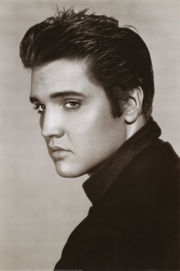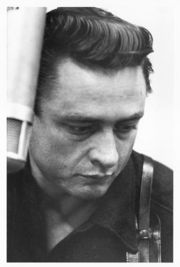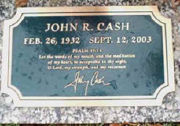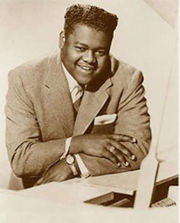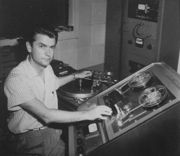The Fifties Rock and Roll
From fifties
Contents |
[edit] Elvis Presley
Elvis Presley was no doubt the king of rock and roll during the 1950s. He introduced a whole new controversy to a white man singing like a black. However, it was the style of music Sam Phillips from Sun Records was hoping to find. Sam Phillips wanted to find a musician who can sing rhythm and blues with "boogie woogie" vibes because he thought that could sell. Sam's instinct was right, it did sell, all because of Elvis Presley.
The controversy between Elvis and the American family in the 1950s was that his movements were too sexual for the younger crowd. The parents would disagree with Elvis' ravish behavior that his music turned into a rebellion with the teenagers. There was also constant jealousy with teenage boys too because of the girls that are always at his concerts. Although his music was a controversy to the parents during this generation, he also caused a bit of confusion with his ability to sing like a black man. A lot of black musicians undoubtedly believed Elvis stole their rhythm and blues style.
His death lead to a legacy for his controversy. Black musicians may find his music as a "stolen" piece during the time of his presence, but in reality he opened doors to black musicians such as: Fats Domino, Chuck Berry, Little Richard, et cetera.
[edit] Johnny Cash
Johnny Cash's rock and roll vibe have a twang of country, folk, blues, and gospel. He was also known as the nickname "The Man in Black".
In his early life, he had a difficult relationship with his father because his father didn't understand his music sense, and favored his older brother, Jack, who died from a table saw accident, leaving him almost in two. Cash joined the United States Air Force, and during training, he met his first wife Vivian Liberto. They had four daughters together, and moved to Memphis, Tennessee. During his early career in music, he developed a drug addiction which lead to a divorce with Vivian. He cleaned up his act while June, Maybelle, and Ezra Carter stayed at his lake house property for a month. He then proposed to June on stage in Ontario, and June agreed to marry him after he cleaned up. They married a week later in Kentucky. They later introduced their first and only child together, a son named John Cater Cash.
He performed at various prisons because he felt a great compassion for them. A few of the prisons were Falsom Prison, San Quentin, and the Österåker Prison in Sweden. His wife, June, died on May 15th, 2003. He continued working because June has asked him to, but four months later, Cash died.
[edit] Buddy Holly
Buddy Holly was influenced by Elvis Presley when he first saw him live in 1955 at Lubbock, Texas. He then formed a band called The Crickets. However, Elvis Presley have put black music into his songs, which in fact made it acceptable to the white crowd, but Holly had majority of the black crowd.
Holly met Maria Elena Santiago when she was working for Peer-Southern Music. On the first date he proposed to her, and got married in Lubbock, Texas (Holly's birth town) two months after they first met. Holly's wife became a widow after 6 months into the marriage and lost their child during the time of his death.
"The Day the Music Died" was described when Holly's plan crashed and ended his short life.
The way Holly played his instruments is considered the novel for rock and roll.
[edit] Fats Domino
Fats Domino, whose given name is Antoine Domino, was born in 1928 in New Orleans. Nobody could predict that he would become one of the earliest and best rock and roll stars from small beginnings in 1949, and continuing a stream of hits for decades. Fats grew up with music from a very young age, learning to play the piano and sing when he was nine. In fact, his first public performance was at the age of 10, and he kept working small venues until he was playing alongside such New Orleans legends as Professor Longhair and Amos Milburn. Around this time, he was also exposed to the stride and boogie-woogie piano techniques of Fats Waller and Albert Ammons. Soon he mastered the New Orleans R&B piano style, composed of easy-rolling left-hand patterns anchoring right-hand arpeggios. At the age of 20, he was married and a father, had survived a near-fatal car crash, and had almost lost his hand in a factory accident. By this time, he was a well-rounded musician, and people began to notice he was going somewhere with his piano laden, R&B inspired, rock and roll sounds. The next person he would connect with would change his life forever, and vault him to the forefront of early rock and roll. His name was Dave Bartholomew.
Domino met Dave around 1940, when he was a trumpet player in an area band, and the two soon became friends, and business partners. This relationship would prove to be very important, as Domino was more than a sideman to Dave’s band, and Bartholomew helped arrange his contract with Imperial records and became his producer. In 1949, their first effort produced “The Fat Man,” which went on to sell over a million copies, and exposed the nation to the rock and roll flavored “New Orleans sound.” Domino and Dave cowrote most of the albums material. In the mid ’50s, Domino was already a recognized hit maker, with hits such as, "Goin' Home" in 1952, and "Going to the River” in 1953, his records selling between half a million and a million copies apiece. Fats had a pounding piano style that was easily adapted to the new wave of rock sounds, although he proved less magnetic than contemporaries like Elvis Presley, Chuck Berry, Jerry Lee Lewis, or Little Richard. Fats Domino truly exploded onto the rock-and-roll scene in 1955 when his song, "Ain't That A Shame", was covered by white recording artist Pat Boone, and secured Fats as a popular sound among the white population, further ingraining the fact that it was music that helped ease the race struggles of the time, as music truly knows no race. Boone's version went to number one, and Domino's version on Imperial went to number ten. The song established both artists as stars. He continued to write songs with Dave Bartholomew, many of which became hits. In 1956, he put five songs in the top forty, including "I'm In Love Again" and Fats' cover of a song that had reached number one for Glenn Miller in 1940, "Blueberry Hill", which went to number two and was Domino's highest charting record ever. For the next five years, Domino continued a string of hits and eventually collected 23 gold singles, securing his name as one of the greats. In 1957 he appeared in a movie that many consider to be the best rock-and-roll film ever made, "The Girl Can't Help It", singing his hit "Blue Monday". Another Fats Domino hit, "I'm Walkin'", was covered by Ricky Nelson in 1957 and helped to launch the teens singing career. “Walkin’ to New Orleans”, released in 1960, would prove to be his last million seller. In 1963, he left Imperial records for ABC. Shortly after, he went through several other companies such as Mercury, Warner Bros., Atlantic, and Broadmoor. None of these companies saw him as successful as when he was with Imperial. His next revival would come in 1968 with a cover of the Beatles’ “Lady Madonna.” The Beatles always sang the Fat Man’s praises, as on some of their material, the Beatles did little more use some of the techniques and sounds from the early Domino-Bartholomew records. Fats would never again reach the level of stardom and popularity that he enjoyed throughout the 1960’s and ‘70’s. He continued to tour throughout the 1990’s, releasing in 1993 his first major label album in 25 years. This album, entitled “Christmas Is a Special Day”, earned critical acclaim, but very poor sales. That same year, he received a National Medal of the Arts from President Bill Clinton. Currently, Fats lives in New Orleans, where his music has influenced many, his career began, and his heart belongs.
[edit] James Brown
The Godfather of Soul, The King of Funk, and The Hardest Working Man in Show Business. These titles are familiar to generations of music lovers all over the world. The man who had these titles bestowed upon him was none other than James Brown. He was born in Barnwell, South Carolina during the Great Depression era, to Suzie and Joseph Gardner Brown. His parents separated when he was around four years old, and James continued to live with his father and his live-in girlfriends until he was six years old. After that, he moved in with his Aunt, who ran a house of prostitution. James spent a lot of time on the streets, hustling to get quick cash. He managed to stay in school until he dropped out in the seventh grade. Brown also made money by doing odd jobs, such as picking cotton, shining shoes, sweeping out stores and other menial tasks. While trying to keep some cash in his pockets he learned to play the harmonica that his father had given him. He also learned to play the guitar from a man named Tampa Red, a customer of his aunt’s prostitution operation. Brown also found the time to learn to play the drums and even the piano. He was inspired to come into the entertainment industry after watching Louis Jordan, who was a popular Jazz singer in the 1940s. In his free time, he practiced his musical skills in the local halls of Augusta, Georgia. He also began to commit petty crimes, and at the age of sixteen, was convicted of armed robbery, spending time in a juvenile detention facility in 1948. After that, he held several jobs in such varied fields as boxing and semi-professional baseball. After unsuccessful attempts at these trades, he decided to put his energy into what would be his legacy: music. Brown was also married four times, and had nine children.
Brown is best known for his music, and his eclectic mix of gospel sounds and R&B beats. He began his professional music career in 1953, and came to his highest point of popularity during the 1960’s and 70’s. People where drawn to his thrilling performances and series of smash hit songs. Brown’s music has been deeply influential in the evolution of today’s music, and even the formation of new musical genres. Even though his influence is felt strongly today, Brown never had a number one hit, despite the fact that he held the record for the most singles on the Billboard top 100. Browns early performances where simple, straightforward gospel inspired songs, heavily influenced by singers such as Ray Charles and Little Richard. Browns relationship with Little Richard would have a great impact on his development as a musician and showman. Brown once called Richard his idol, and credited him with being the first to put funk into a rock and roll beat.
During the 1960’s and 70’s James was renowned for his work in social activism, even releasing songs to accompany his messages, to include a 1966 song, “Don’t be a drop out”, as a message to students to stay in school and continue getting an education. President Johnson even commended him on his work with school drop out prevention programs. Brown also performed on television after the death of Martin Luther King Jr. He is credited with preventing riots in the streets with his televised performance. Mayor Kevin White had Browns performance broadcast on Boston’s public television channel multiple times, keeping many potential rioters off the streets, watching Brown perform. Brown continued to perform for a variety of civil rights groups including Jesse Jacksons PUSH, and the Black Panthers Party’s Breakfast program.
James Brown led a full, outgoing life, bringing many people together with his eclectic style and exhilarating performances. Sadly, that life ended on December 25th, 2006, at 1:45 am, from congestive heart failure resulting from complications with pneumonia. His agent, Frank Copsidas, and his close friend, Charles Bobbit were at his bedside. According to Bobbit, Browns last words were, “ I am hopping on the night train,” and then Brown took three slow breaths, and closed his eyes. Though he may no longer be with us, his soul will live on forever in the hearts of millions through his music.
[edit] The Electric Guitar
Guitars have been dated all the way back from 1890, when Orville Gibson designed the curved body of the guitar, which is also found in violins. Since in the 1920s and 1930s, there have been numerous experiments with making instruments electric. The electric viola and string bass has been experimented in the 1930s by an innovator named Lloyd Loar. In the 1950s, an acoustic guitarist named Les Paul, built a guitar named "The Log" on a four-by-four piece of pine. It wasn't until Leo Fender then made the first solid body electric guitar in the 1950s. Musicians carried the Fender and Les Paul guitars for many years following, including Fender's Stratocaster, which was made in the mid-1950s, and still is the top selling electric guitar since then.
[edit] Sun Records
Elvis Presley, Carl Perkins, Roy Orbison and Johnny Cash. Familiar names to many generations of rock and roll fans, but they may not have had the chance to showcase their musical talents and influence music forever had it not been for Sun Records. The Sun Records company was a major driving force behind the expansion of the rock and roll genre into mainstream music in the 1950’s, giving the aforementioned artists their first major recording contracts. The company was mostly known for signing African American artists on their label, but executives wanted to record the sounds of R&B for a white audience. Rock and Roll, with its R&B influence and rhythm, was the perfect vehicle with which to deliver the styles that Sun Records wanted to bring to a larger audience. The artists that Sun Records recorded were the forefathers of a large part of today’s musical culture, and without the insight and ambition that the company had, music would probably not be as diverse as it is today. Sun Records may now be functionally defunct, having been absorbed into a larger parent organization, Sun Entertainment, but their legacy lives on, both in the classic reissued recordings of the pioneers of rock and roll, to the lasting impression they have left on the world of music.
[edit] Bibliography
"Fats Domino." Wikipedia. 30 Apr.-May 2008. 08 Apr.-May 2008 <http://www.en.wikipedia.org/wiki/Fats_Domino>.
"James Brown." Wikipedia. 04 May-June 2008. 08 Apr.-May 2008 <http://www.en.wikipedia.org/wiki/James_Brown>.
"Sun Records." Wikipedia. 01 May-June 2008. 20 May-June 2008 <http://www.en.wikipedia.org/Sun_Records>.
"James Brown: 'the Godfather of Soul,' Dies At 73." CNN. 25 Dec. 2006. 08 Apr.-May 2008 <http://www.cnn.com/2006/SHOWBIZ/music/12/25/obit.brown/index.html>.
Edwards, David, and Mike Callahan. "The Sun Records Label Story." 18 June-July 1999. 12 Apr.-May 2008 <http://www/bsnpubs.com/tennesse/sunstory.html>.
Coleman, Rick. Blue Monday: Fats Domino and the Lost Dawn of Rock'N' Roll. Da Capo P, 2007.
"Elvis Presley." Wikipedia. 04 May-June 2008. 08 Apr.-May 2008 <http://www.en.wikipedia.org/wiki/Elvis_Presley>.
"Johnny Cash." Wikipedia. 04 May-June 2008. 08 Apr.-May 2008 <http://www.en.wikipedia.org/wiki/Johnny_Cash>.
"Buddy Holly." Wikipedia. 04 May-June 2008. 08 Apr.-May 2008 <http://www.en.wikipedia.org/wiki/Buddy_Holly>.
Brain, Marshall. "Electric Guitar History." How Stuff Works. May 2008 <http://entertainment.howstuffworks.com/electric-guitar3.htm>.
Brain, Marshall. "Electric Guitar History." How Stuff Works. May 2008 <http://entertainment.howstuffworks.com/electric-guitar3.htm>.
